Fall is a season of vibrant colors, crisp air, and cozy outdoor spaces. One of the easiest ways to bring the beauty of autumn into your garden, porch, or balcony is through fall container arrangements. These versatile displays allow gardeners to combine flowers, foliage, fruits, and decorative elements to create eye-catching seasonal arrangements that can be moved, updated, or layered throughout the fall months.
This article explores how to make stunning fall container arrangements, including plant selection, design principles, soil preparation, and seasonal maintenance tips to help you create long-lasting and vibrant fall displays.
Why Fall Container Arrangements Are Popular
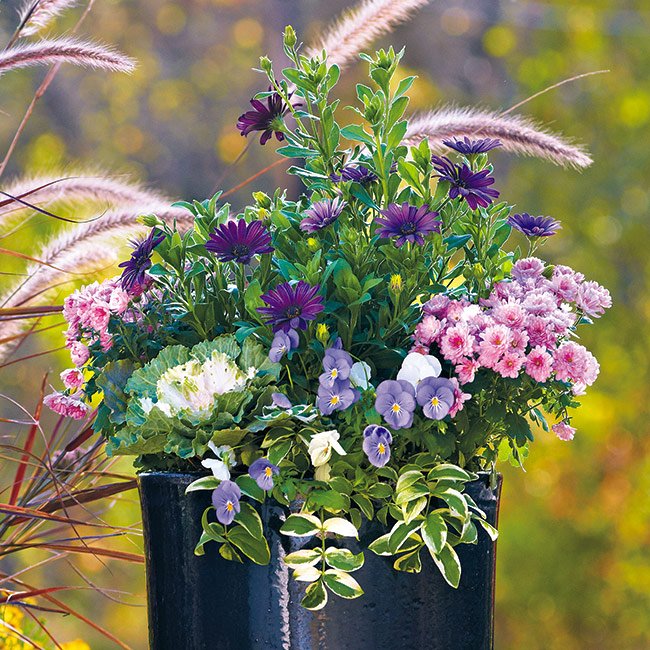
Fall container arrangements are popular for several reasons:
- Versatility: Containers can be placed on porches, patios, steps, or balconies, transforming small or large spaces.
- Seasonal Expression: Fall is synonymous with rich reds, oranges, yellows, purples, and deep greens; containers make it easy to showcase these colors.
- Extended Gardening Season: Even as garden beds slow down, containers allow for continued planting and visual appeal.
- Easy Maintenance: Container arrangements are simpler to care for than large garden beds, with focused watering, fertilization, and pruning.
- Creative Freedom: Gardeners can mix plants, textures, and ornamental elements like pumpkins, gourds, or decorative sticks for unique displays.
By combining plants, foliage, and decorative touches, fall container arrangements can add charm, color, and seasonal flair to any outdoor or indoor space.
1. Choose the Right Container
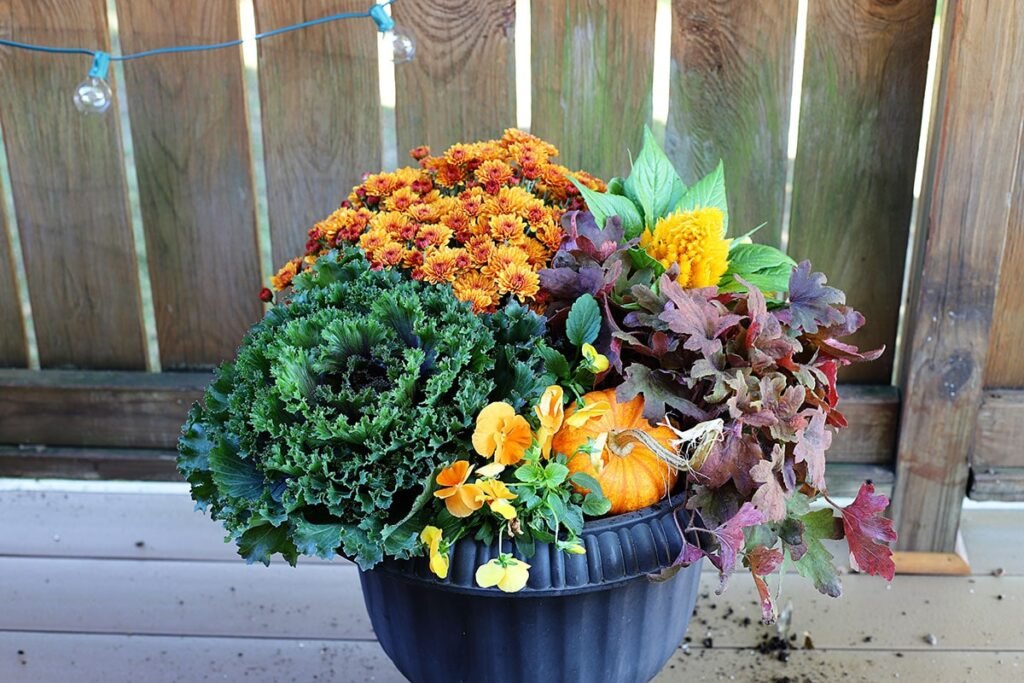
The foundation of any successful fall arrangement is the container itself.
Considerations:
- Size: Choose a container that accommodates root growth for your selected plants. Large arrangements allow for multiple plant layers.
- Material: Clay, ceramic, wood, metal, or plastic containers each have different drainage, insulation, and aesthetic qualities.
- Drainage: Ensure holes are present to prevent waterlogging, which can damage roots.
- Style: Select a container that complements your outdoor décor, whether rustic, modern, or traditional.
Tip: Layer containers of varying heights and shapes for a dynamic display. Tall containers can hold cascading plants, while shallow containers highlight low-growing blooms.
2. Select Plants for Fall
Fall container arrangements rely on plants that thrive in cooler temperatures and complement autumnal colors.
Popular Plant Choices:
Flowers
- Chrysanthemums: Iconic fall blooms in reds, yellows, oranges, and purples
- Pansies: Hardy, vibrant flowers that tolerate light frost
- Asters: Long-blooming perennials adding texture and color
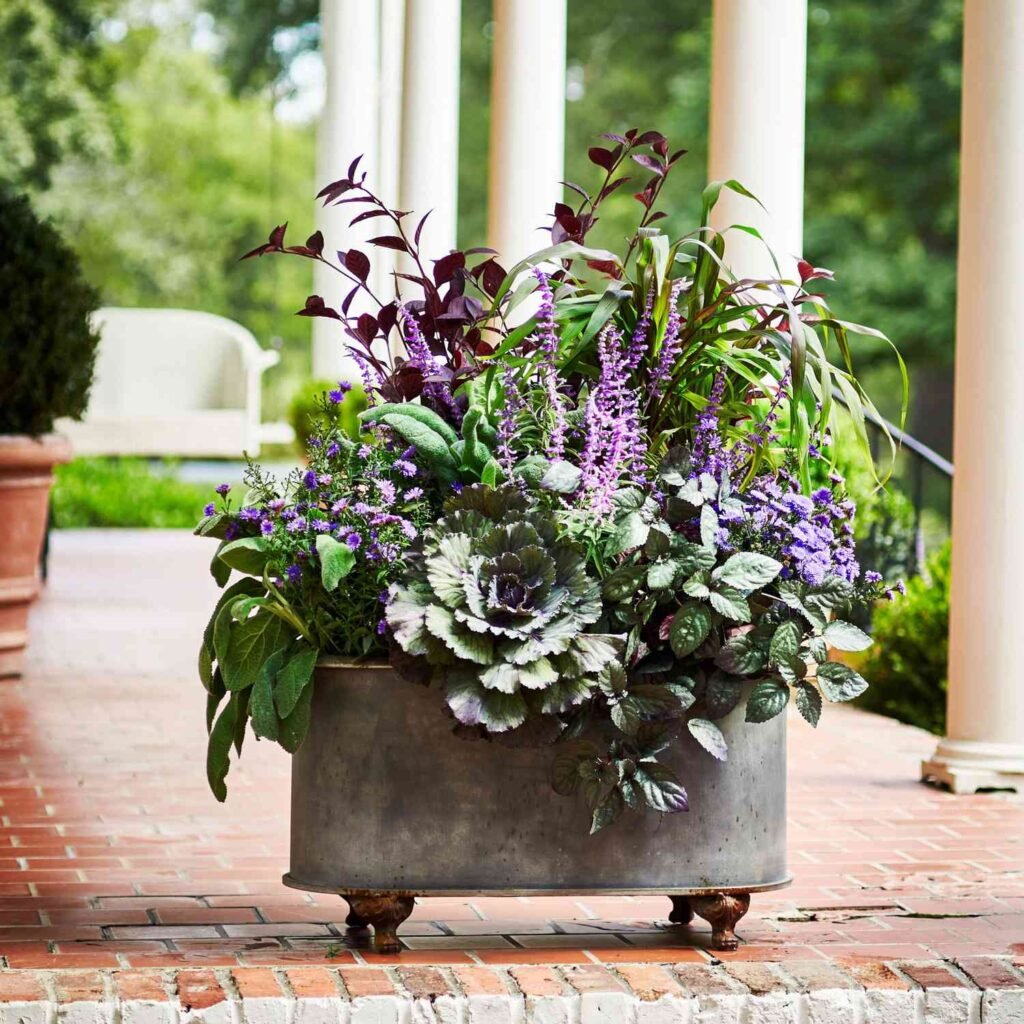
Foliage Plants
- Ornamental Kale and Cabbage: Colorful, frost-tolerant leaves in purple, white, and green
- Heuchera (Coral Bells): Bold foliage with shades of burgundy, orange, and green
Small Shrubs and Evergreens
- Dwarf Conifers: Provide structure and year-round greenery
- Boxwood or Holly: Add height, texture, and a backdrop for colorful blooms
Edible Plants and Herbs
- Parsley, Thyme, and Sage: Attractive greenery that survives cooler temperatures
- Fall Vegetables: Lettuce, spinach, and Swiss chard add both color and utility
Tip: Mix plants with different textures, heights, and colors for visual interest. Use a thriller-filler-spiller approach: tall plants (thrillers) for height, medium plants (fillers) for volume, and trailing plants (spillers) to cascade over edges.
3. Prepare the Soil
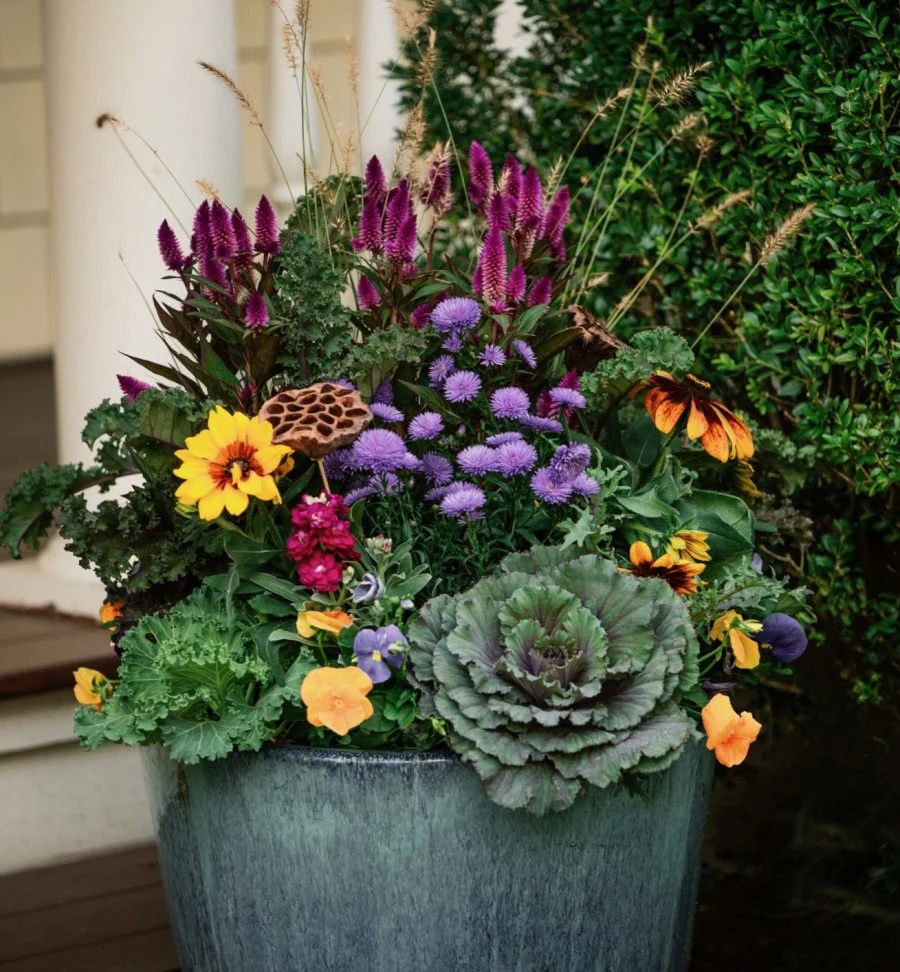
Good soil is critical for healthy fall container arrangements.
Steps:
- Use a high-quality potting mix, ideally soilless for better drainage and aeration.
- Mix in compost or organic fertilizer to provide nutrients for slow-growing fall plants.
- Ensure the soil is light and loose to prevent compaction and allow roots to penetrate easily.
- For larger containers, consider layering soil with gravel or broken pottery at the bottom to improve drainage.
Tip: Avoid garden soil, which can compact and limit root growth in containers.
4. Design Principles for Stunning Arrangements
Successful fall container arrangements follow key design principles:
Color Coordination
- Use warm autumn colors like red, orange, yellow, and burgundy.
- Add contrast with green foliage or silver-gray accents like dusty miller.
Texture and Layering
- Combine smooth leaves with ruffled foliage (like kale) or spiky plants (like ornamental grasses).
- Use trailing plants to soften container edges and create flow.
Height Variation
- Place taller plants in the center or back (thrillers).
- Medium-height plants around them (fillers).
- Trailing plants at edges (spillers) to complete the layered look.
Decorative Elements
- Add mini pumpkins, gourds, pinecones, or dried cornstalks for visual interest.
- Incorporate seasonal ornaments like lanterns, scarecrows, or rustic twine for extra charm.
Tip: Step back and view your arrangement from different angles to ensure balance, symmetry, and visual appeal.
5. Watering and Maintenance
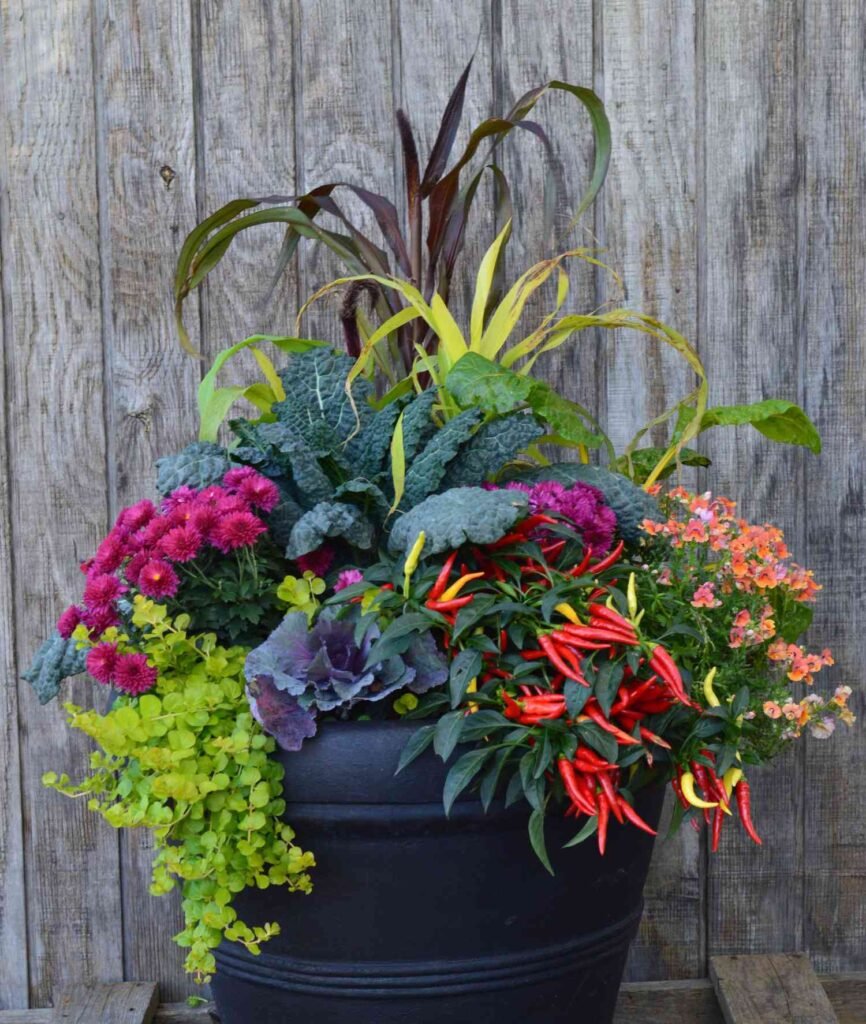
Fall container arrangements require careful maintenance to remain vibrant:
Watering:
- Water thoroughly, keeping soil evenly moist but not soggy.
- Cool fall temperatures may reduce evaporation, so adjust watering frequency accordingly.
Fertilization:
- Use a slow-release or liquid fertilizer every 3–4 weeks to replenish nutrients.
- Avoid excessive nitrogen, which encourages leafy growth over flowers.
Pruning and Deadheading:
- Remove faded flowers to encourage continuous blooms.
- Trim overly long or leggy stems to maintain shape.
Protection:
- Move containers to sheltered areas during early frosts.
- Consider using frost cloths or indoor placement for sensitive plants.
6. Creative Fall Arrangement Ideas
Rustic Harvest Display
- Combine orange chrysanthemums, purple ornamental kale, and trailing ivy in a large wooden barrel.
- Add small pumpkins and gourds around the base for a harvest feel.
Cozy Porch Arrangement
- Use pansies, heuchera, and dwarf evergreens in matching ceramic pots.
- Add a small lantern or autumn-themed sign for charm.
Edible and Decorative Combo
- Mix parsley, sage, and lettuce with mini pumpkins or ornamental peppers.
- Ideal for small balconies, providing both beauty and utility.
Layered Vertical Display
- Stack containers of different heights with cascading plants like ivy or creeping Jenny.
- Fill upper tiers with chrysanthemums and asters for color contrast.
Tip: Experiment with seasonal themes and rotate plants throughout fall to maintain freshness and color.
Environmental and Aesthetic Benefits
- Seasonal Color: Enhances outdoor spaces with autumnal beauty
- Urban Gardening: Allows gardening in apartments, patios, and balconies
- Pollinator Support: Some fall flowers provide late-season nectar for bees and butterflies
- Sustainability: Containers can be reused, rotated, or planted for edible harvests
Fall container arrangements not only create visual impact but also offer functional and sustainable gardening solutions in limited spaces.
Final Thoughts
Fall container gardening is a creative, rewarding, and versatile way to enjoy the beauty of the season. By selecting the right container, plants, and soil, and following design principles such as layering, color coordination, and texture variation, gardeners can create arrangements that remain vibrant throughout autumn.
From classic chrysanthemums and pansies to ornamental kale, herbs, and small shrubs, fall container arrangements combine beauty, utility, and seasonal charm. With proper watering, fertilization, and maintenance, these arrangements can thrive well into late fall, providing a warm, welcoming, and visually stunning atmosphere for your outdoor or balcony spaces.
Whether decorating a front porch, balcony, or patio, fall container arrangements offer flexibility, creativity, and long-lasting seasonal impact, making them a perfect choice for gardeners of all skill levels.
